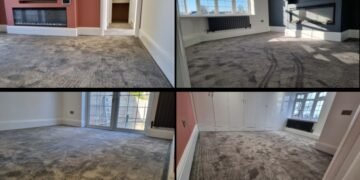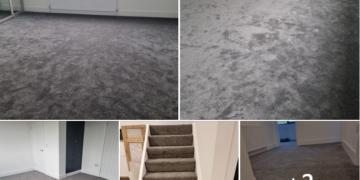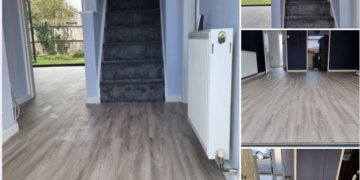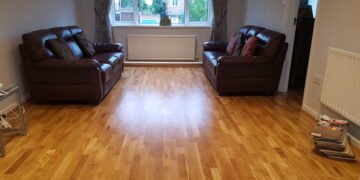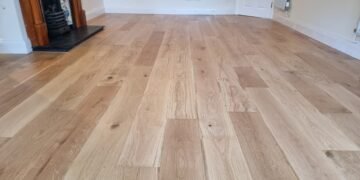3. Advantages of Laminate Flooring
Laminate flooring offers several benefits that make it a popular choice among homeowners and builders:
a. Cost-Effective
- Laminate flooring is much more affordable than natural hardwood, stone, or tile, making it a budget-friendly option that still provides the aesthetic appeal of more expensive materials.
- It also requires less maintenance and lower installation costs, which contributes to overall savings.
b. Durability
- Thanks to its multi-layer construction, laminate flooring is highly durable and can withstand heavy foot traffic, making it an excellent choice for high-traffic areas such as living rooms, hallways, and kitchens.
- The top wear layer is resistant to scratches, scuffs, and stains, making it suitable for households with pets or children.
c. Wide Variety of Designs
- Laminate flooring comes in a vast array of styles, colors, and textures, allowing homeowners to choose from designs that replicate hardwood, stone, ceramic tile, and more.
- You can find laminate floors that mimic different wood species (oak, maple, walnut), stone patterns (slate, marble), and even more unique textures like distressed or hand-scraped wood.
d. Easy Installation
- Most laminate flooring features a “click-lock” or tongue-and-groove system, which allows the planks to snap together without the need for glue or nails. This floating floor system can be installed over various types of subfloors, including plywood, concrete, or existing flooring.
- The easy installation process makes laminate a popular choice for DIY enthusiasts, as it can be laid without professional help.
e. Low Maintenance
- Laminate flooring is easy to clean and maintain. Regular sweeping and occasional damp mopping are usually sufficient to keep it looking good. It doesn’t require polishing or refinishing, as hardwood floors do.
- Its stain-resistant surface makes it an excellent choice for households prone to spills.
f. Moisture Resistance
- While traditional laminate flooring is not fully waterproof, many modern laminate options come with water-resistant cores or special coatings, making them suitable for kitchens, laundry rooms, and even bathrooms.
g. Eco-Friendly Options
- Laminate flooring is made from recycled wood materials, and many manufacturers follow eco-friendly practices, offering sustainable options for homeowners who prioritize environmentally responsible products.
4. Disadvantages of Laminate Flooring
Although laminate flooring has many benefits, there are a few potential drawbacks to consider:
a. Moisture Sensitivity
- Standard laminate flooring is not fully waterproof, and prolonged exposure to moisture can cause it to warp or swell. However, water-resistant or waterproof laminate options are available, but they may be more expensive.
b. Cannot Be Refinished
- Unlike hardwood flooring, laminate cannot be sanded down or refinished. Once the wear layer is damaged, the plank needs to be replaced. If deep scratches or dents occur, individual boards must be removed and replaced, rather than refinishing the entire floor.
c. Artificial Feel
- While laminate can mimic the look of real wood or stone, it doesn’t have the same warmth or texture underfoot. Some homeowners may find it less appealing than natural materials because it can feel harder or less authentic.
5. Installation Process
Laminate flooring installation is relatively simple and follows these steps:
a. Subfloor Preparation
- Ensure the subfloor is clean, dry, and level. Laminate can be installed over concrete, plywood, or existing flooring, as long as the surface is flat and stable.
b. Underlayment
- Install an underlayment, which provides cushioning, soundproofing, and moisture resistance. Some laminate planks come with pre-attached underlayment, while others require a separate underlayment layer.
c. Laying the Laminate
- Begin laying the laminate planks by snapping them together using the click-lock system. Start in one corner of the room and work your way across, leaving a small expansion gap around the perimeter to allow for the laminate to expand and contract with temperature and humidity changes.
d. Cutting and Fitting
- As you approach walls, corners, and doorways, cut the planks to fit using a saw. Ensure a tight fit without damaging the boards.
e. Finishing Touches
- Install baseboards or quarter-round trim around the edges of the room to cover the expansion gap and give the floor a polished finish.
6. Maintenance Tips
- Regular Cleaning: Sweep or vacuum regularly to remove dirt and debris. Use a damp mop for deeper cleaning, but avoid soaking the floor.
- Avoid Harsh Chemicals: Use a cleaner specifically designed for laminate floors to prevent damage to the wear layer.
- Furniture Pads: Place felt pads under furniture legs to avoid scratches, and use rugs in high-traffic areas for extra protection.
- Spill Management: Clean up spills immediately to avoid moisture seeping into the seams, especially if you don’t have water-resistant laminate.
7. Where to Use Laminate Flooring
Laminate flooring is versatile and can be used in most areas of the home:
- Living rooms and bedrooms: Ideal for creating a warm and inviting atmosphere.
- Hallways and entryways: Durable enough to handle foot traffic and easy to clean.
- Kitchens: Water-resistant laminate can be used, though spills should be cleaned up quickly.
- Basements: With proper moisture barriers, laminate can be used in below-grade installations.
Conclusion
Laminate flooring is an excellent choice for homeowners looking for a cost-effective, durable, and aesthetically pleasing flooring option. With its variety of designs, ease of installation, and low maintenance requirements, laminate is a versatile solution that can be used throughout the home. Although it may not have the warmth of natural hardwood, modern laminate floors offer realistic looks and durability that can last for years with proper care.
Laminate flooring is a popular and versatile option for residential and commercial spaces due to its affordability, durability, and wide variety of design choices. Here’s a detailed breakdown of what laminate flooring is, its structure, benefits, installation, and maintenance:
1. What is Laminate Flooring?
Laminate flooring is a synthetic product made to resemble natural materials like hardwood, stone, or tile. It is composed of multiple layers, each serving a specific function, and is designed to mimic the look of more expensive flooring options at a fraction of the cost.
2. Structure of Laminate Flooring
Laminate flooring consists of four main layers:
a. Wear Layer (Top Layer)
- This is a transparent, protective surface that shields the floor from daily wear and tear. It provides resistance against scratches, stains, fading, and dents. The wear layer ensures the longevity of the flooring, making it suitable for high-traffic areas.
- It also includes UV protection, which prevents the colors from fading due to exposure to sunlight.
b. Design Layer
- Beneath the wear layer is the design layer, where a high-resolution printed image of wood, stone, or tile is embedded. This is what gives the laminate its realistic appearance, allowing it to mimic the texture and look of natural materials.
- Modern printing technology allows for detailed and textured images, making it difficult to distinguish laminate flooring from the real thing at first glance.
c. Core Layer
- The core layer is made of high-density fiberboard (HDF) or particleboard, providing strength, stability, and durability. This layer is responsible for the floor’s resilience and its ability to withstand impact and foot traffic.
- Some laminate flooring products come with moisture-resistant cores, making them more suitable for areas like kitchens or bathrooms.
d. Backing Layer
- The bottom layer acts as a moisture barrier and provides additional stability to the flooring. It prevents moisture from seeping up from the subfloor and helps to balance the structure, ensuring the floor remains flat and stable over time.

